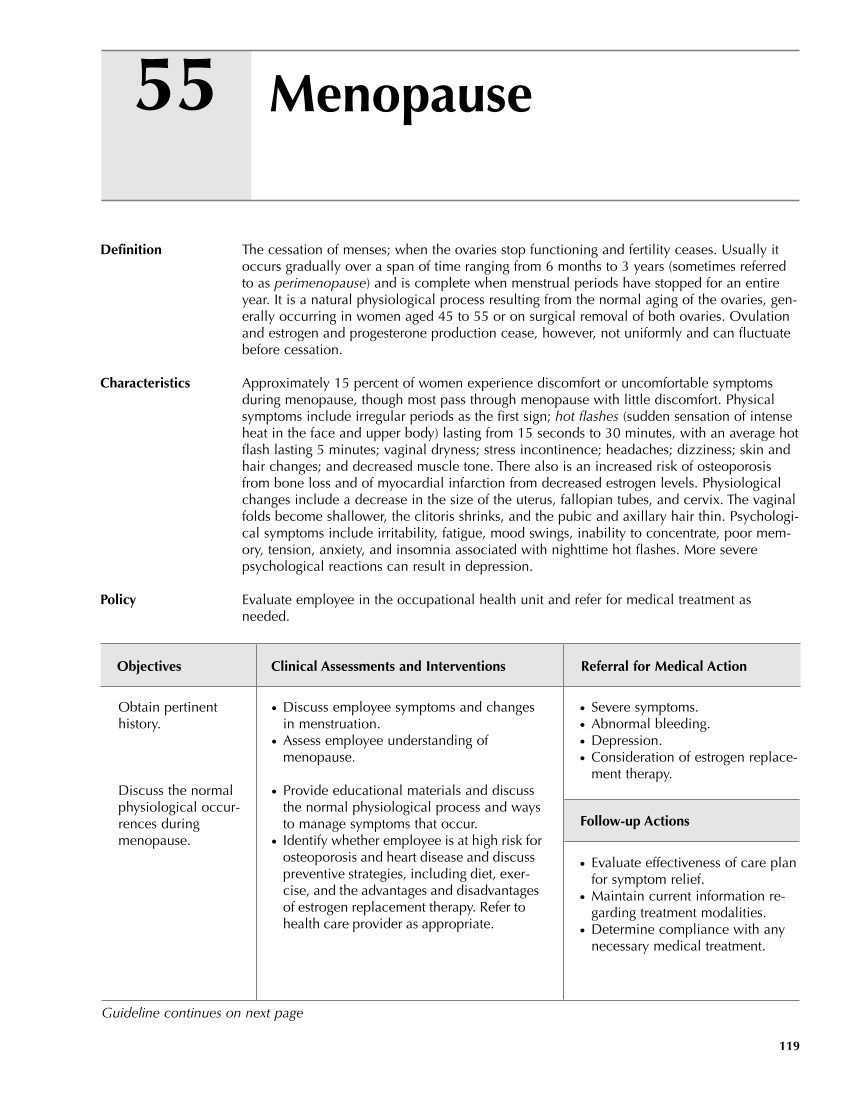119 Menopause 55 Definition The cessation of menses when the ovaries stop functioning and fertility ceases. Usually it occurs gradually over a span of time ranging from 6 months to 3 years (sometimes referred to as perimenopause) and is complete when menstrual periods have stopped for an entire year. It is a natural physiological process resulting from the normal aging of the ovaries, gen- erally occurring in women aged 45 to 55 or on surgical removal of both ovaries. Ovulation and estrogen and progesterone production cease, however, not uniformly and can fluctuate before cessation. Characteristics Approximately 15 percent of women experience discomfort or uncomfortable symptoms during menopause, though most pass through menopause with little discomfort. Physical symptoms include irregular periods as the first sign hot flashes (sudden sensation of intense heat in the face and upper body) lasting from 15 seconds to 30 minutes, with an average hot flash lasting 5 minutes vaginal dryness stress incontinence headaches dizziness skin and hair changes and decreased muscle tone. There also is an increased risk of osteoporosis from bone loss and of myocardial infarction from decreased estrogen levels. Physiological changes include a decrease in the size of the uterus, fallopian tubes, and cervix. The vaginal folds become shallower, the clitoris shrinks, and the pubic and axillary hair thin. Psychologi- cal symptoms include irritability, fatigue, mood swings, inability to concentrate, poor mem- ory, tension, anxiety, and insomnia associated with nighttime hot flashes. More severe psychological reactions can result in depression. Policy Evaluate employee in the occupational health unit and refer for medical treatment as needed. Objectives Clinical Assessments and Interventions Referral for Medical Action ● Severe symptoms. ● Abnormal bleeding. ● Depression. ● Consideration of estrogen replace- ment therapy. Follow-up Actions ● Evaluate effectiveness of care plan for symptom relief. ● Maintain current information re- garding treatment modalities. ● Determine compliance with any necessary medical treatment. Obtain pertinent history. Discuss the normal physiological occur- rences during menopause. ● Discuss employee symptoms and changes in menstruation. ● Assess employee understanding of menopause. ● Provide educational materials and discuss the normal physiological process and ways to manage symptoms that occur. ● Identify whether employee is at high risk for osteoporosis and heart disease and discuss preventive strategies, including diet, exer- cise, and the advantages and disadvantages of estrogen replacement therapy. Refer to health care provider as appropriate. Guideline continues on next page
Purchased from OEM Press by (ge corporate access). (C) 2013 OEM Health Information, Inc. All rights reserved.












































































































































































































































































































































































































































